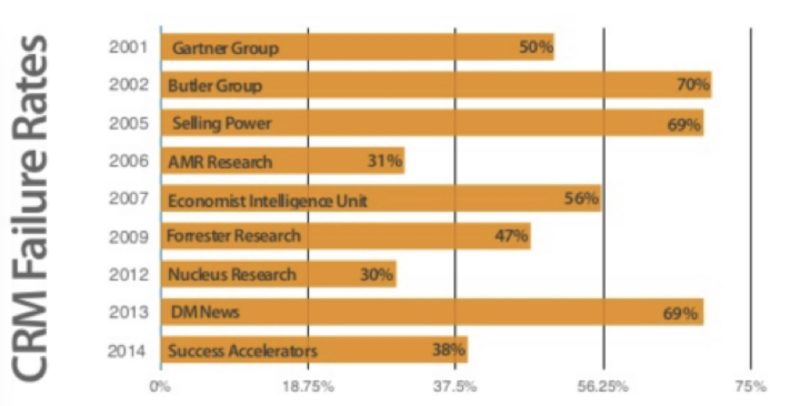
By Mark Boundy
CRM: Is the Tail Wagging the Dog?
CRM: Is the Tail Wagging the Dog? https://csuiteold.c-suitenetwork.com/advisors/wp-content/themes/csadvisore/images/empty/thumbnail.jpg 150 150 Mark Boundy https://secure.gravatar.com/avatar/fda1708afcd4681826f4fb12f56401d9?s=96&d=mm&r=g
Note: This is the first of a three part series on how sales performance management is evolving
According to their marketing materials, Customer Relationship Management (CRM) applications solve just about every sales problem your company has ever experienced. Are the promises true? Or…does CRM just help make your existing processes (good or bad) more efficient –at best? Do your sales people feel like you own your CRM or that your CRM owns them? Is CRM the tail wagging the dog?
CRM systems have powerful functionality, and are able to analyze more data all the time. And yet, an alarming percentage of CRM implementations don’t meet expectations – see the chart below (CIO magazine recently found 33%, a more current figure, but not out of line with history). Those numbers look worse when you examine how “expectations” were defined.
What’s going on? CRM Alone is Not Enough
There are a couple of reasons why CRM implementations miss expectations:
They typically focus on selling process alone. I’ll discuss this in greater depth next week, but selling process is the easy part: aligning with the customer’s buying process is where big gains in effectiveness happen.
CRM can only analyze the data it has access to. Order history reports tend to be pretty accurate, but opportunity pursuit data is almost always sketchy at best…especially for lower-performing sales people.
For sales people, CRM is often simply a compliance tool; that is, it’s an administrative system to track actions. If it doesn’t help sales people win opportunities, it doesn’t get used.
Even worse, the actions tracked aren’t quality actions that lead to success, and everyone knows it. If CRM’s intent is to streamline customer interactions, most implementations don’t measure up. Why? Many companies fall into the trap of tracking what is easy to capture, not what’s important. Analyzing non-predictive data gets you lots of numbers, charts and graphs, but no real insights.
The tail wagging the dog:
If all CRM is in your organization is a tool to track (the wrong) activities… and you’ve become a slave to tracking those activities, you exist to serve your CRM, not the other way around.
There is a huge difference between a tool that makes sellers more effective and one used by managers to gather semi-meaningful data. While I don’t want to ignore the importance of lightening a front-line sales manager’s reporting burden, that benefit may not be worth the cost s of implementation.
While they’re billed as sales performance tools, most companies’ CRM implementations fall short. When CRM becomes merely a compliance and reporting tool, you’re in trouble.
Worse, if you fall into the trap of measuring only the wrong activities (unfortunately, that means measuring activities that CRM finds easiest to measure and track), you’re in the worst kind of trouble. You’re not leading with measuring the right things. Opportunity counts mean nothing. Winnable opportunity tracking means something. Understanding how to turn an at-risk opportunity into a winnable one is everything.
What should CRM be and do?
While CRM should also be able to analyze post-sale information, it should be a tool for sales professionals. Companies should set a high bar for their expectations. To be a genuine tool for sellers and their leaders, the next generation of CRM needs to:
1. Drive effective selling behaviors(not mere activity tracking). My expertise is selling behaviors that drive sales – as opposed to activities that sales people could perform. For example: I want to drive great conversations with the right people, not number of calls completed. Today’s CRM implementations typically help leaders track the latter, when they know they should be driving the former. The ideal CRM should help alert sales people to the right behaviors at the right times.
2. Change deal outcomes: using expertise, a CRM system should proactively identify which opportunities in your funnel are at risk…and more importantly, why. That same CRM system should automatically tell individual sellers what to do about it. Early risk identification and management (mitigation or de-resourcing) would be gold in the hands of a selling organization.
3. Replicate Winning Behaviors. The sales behaviors that predict selling success are observable, trainable, trackable and coachable. Uncovering those behaviors, then replicating them sales force-wide by training, coaching, and tracking those behaviors, allows you to bring all of the sellers on a team to a higher level. A CRM that does this would be a huge advantage for a selling organization.
Where CRM has been. Where It’s Going
CRM has evolved through three major generations:
- Contact manager.An automated Rolodex and tickler file.
- Massive powerful DB that does everything – some are capable of managing the ordering and assembly logistics of a space shuttle…although integrating proposals and contracts with enterprise resource planning, etc. were common uses.
- Today, State of the art CRMs “’Manage’ the selling process”; that is, ather seller data on their activities.
- Activity-based selling fits today’s CRM tools best.
- Activities and behaviors that align selling activities with customer buying processes (customer-centric sales methodologies) are firmly out-of-scope.
My company has had, for years, a skinny software stack for CRMs that allows sellers to practice methodology within CRM. It allowed sellers to benefit from CRM as a performance-enhancement tool. Because of that, many clients find that CRM utilization by sellers dramatically increases, yielding data accuracy benefits to the organization. (Ironically, some companies have bought sales training –at least initially–to finally achieve acceptable compliance with CRM).
Today, even the best coaching is done in-person, by managers examining meeting plans, account plans and opportunity pursuits, diagnosing selling behavior gaps, and conducting coaching conversations. The skinny stack is great for this. Tools that score opportunities and selling methodology behaviors (methodology is what connects sales process to customer buying process) have enhanced the skinny stack tool even further.
The three requirements of a great CRM implementation above are met with this skinny stack. The challenge: coaching is almost 100% in-person, a large demand on front-line-manager time resources.
What if there was a true sellers-first tool, that helped sales professionals be great? What would that look like?
Watch this space…or contact me right away to learn more.
To your success!

